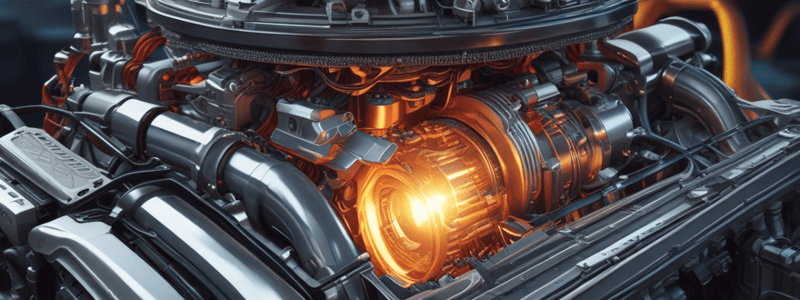Podcast
Questions and Answers
What is the primary function of the engine in a car?
What is the primary function of the engine in a car?
- To convert heat from burning gas into force to turn the wheels (correct)
- To provide power for the electrical systems
- To cool the interior of the car
- To reduce emissions from the exhaust
What are the two basic parts of the engine?
What are the two basic parts of the engine?
- The camshaft and the valves
- The pistons and the crankshaft
- The air intake and the exhaust
- The cylinder block and the cylinder head (correct)
What is the function of the cylinder head?
What is the function of the cylinder head?
- To contain the pistons
- To convert the reciprocating motion of the pistons
- To house the crankshaft
- To control the flow of air/fuel mixture and exhaust gases (correct)
How is the chain of reactions in the engine initiated?
How is the chain of reactions in the engine initiated?
What component converts the reciprocating motion of the pistons into rotary motion?
What component converts the reciprocating motion of the pistons into rotary motion?
What type of engine layout is described as the "simplest and most common"?
What type of engine layout is described as the "simplest and most common"?
What is the purpose of the carburettor in an engine?
What is the purpose of the carburettor in an engine?
What is the function of the piston during the power stroke?
What is the function of the piston during the power stroke?
What is the purpose of the compression ratio in an engine?
What is the purpose of the compression ratio in an engine?
Which component controls the sequence of ignition in the cylinders?
Which component controls the sequence of ignition in the cylinders?
What is the purpose of the exhaust stroke in the four-stroke cycle?
What is the purpose of the exhaust stroke in the four-stroke cycle?
What is the function of the connecting rod in an engine?
What is the function of the connecting rod in an engine?
What is the purpose of the camshaft in an engine?
What is the purpose of the camshaft in an engine?
What is the purpose of the sparkplug in an engine?
What is the purpose of the sparkplug in an engine?
What is the purpose of the sump in an engine?
What is the purpose of the sump in an engine?
What is the function of the inlet valve in an engine?
What is the function of the inlet valve in an engine?
Flashcards are hidden until you start studying
Study Notes
Engine Overview
- The engine is a complex machine that converts heat from burning gas into force that turns the road wheels.
- It is called an internal combustion engine because the combustion process takes place inside the engine.
Engine Structure
- The engine has two basic parts: the cylinder block and the cylinder head.
- The cylinder block is the lower, heavier section that houses the crankshaft and sometimes the camshaft.
- The cylinder head contains valve-controlled passages for air and fuel mixture entry and gas expulsion.
Engine Types
- The most common type of engine is the in-line engine, with cylinders arranged vertically in a row.
- The V-engine is a more compact type, with cylinders arranged opposite each other at an angle.
- The horizontally-opposed engine is an extension of the V-engine, with cylinders arranged at a 180-degree angle.
Power Creation
- The conversion of fuel energy into power starts when petrol is mixed with air in a carburettor.
- The mixture is drawn into the cylinders, compressed, and then ignited by a spark plug.
- The rapid expansion of the burning gas drives the piston down the cylinder, which is then converted into rotary motion by the crankshaft.
Four-Stroke Cycle
- The four-stroke cycle consists of induction, compression, power, and exhaust strokes.
- The induction stroke draws the fuel mixture into the cylinder through the inlet valve.
- The compression stroke compresses the mixture to about an eighth or ninth of its original volume.
- The power stroke drives the piston down the cylinder as the ignited gases expand.
- The exhaust stroke allows waste products to escape through the exhaust system.
Compression Ratio
- The compression ratio is the difference between the volume of the air and fuel mixture and its eventual volume when compressed.
- A compression ratio of 9:1 means the mixture is reduced to one-ninth of its original volume.
Firing Order
- The firing order is the sequence in which the spark plugs ignite the mixture in each engine cylinder.
- The distributor directs the flow of current to each spark plug at the correct time during the four-stroke cycle.
- The spark occurs just before the piston reaches top dead centre (TDC) on the compression stroke.
Studying That Suits You
Use AI to generate personalized quizzes and flashcards to suit your learning preferences.




